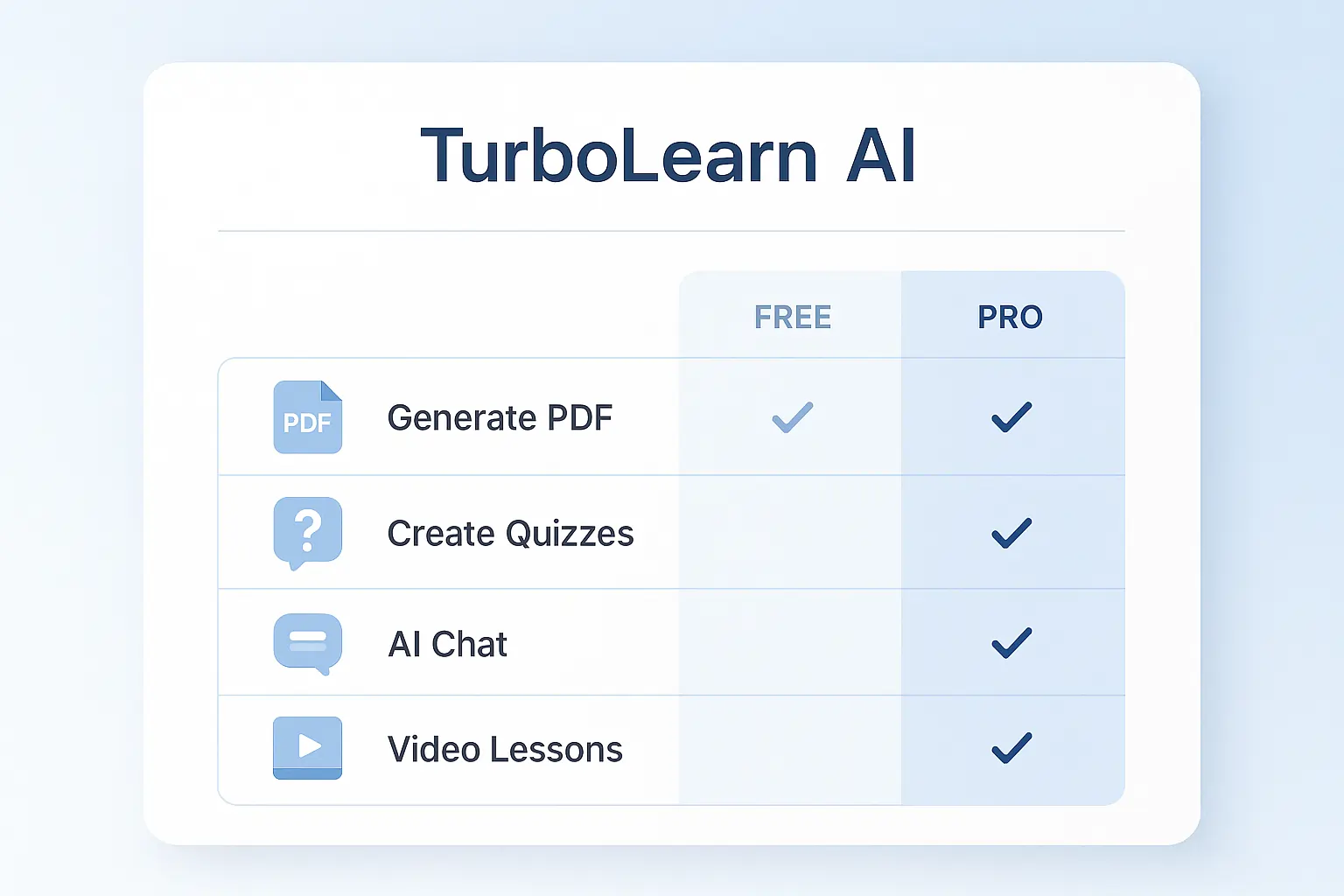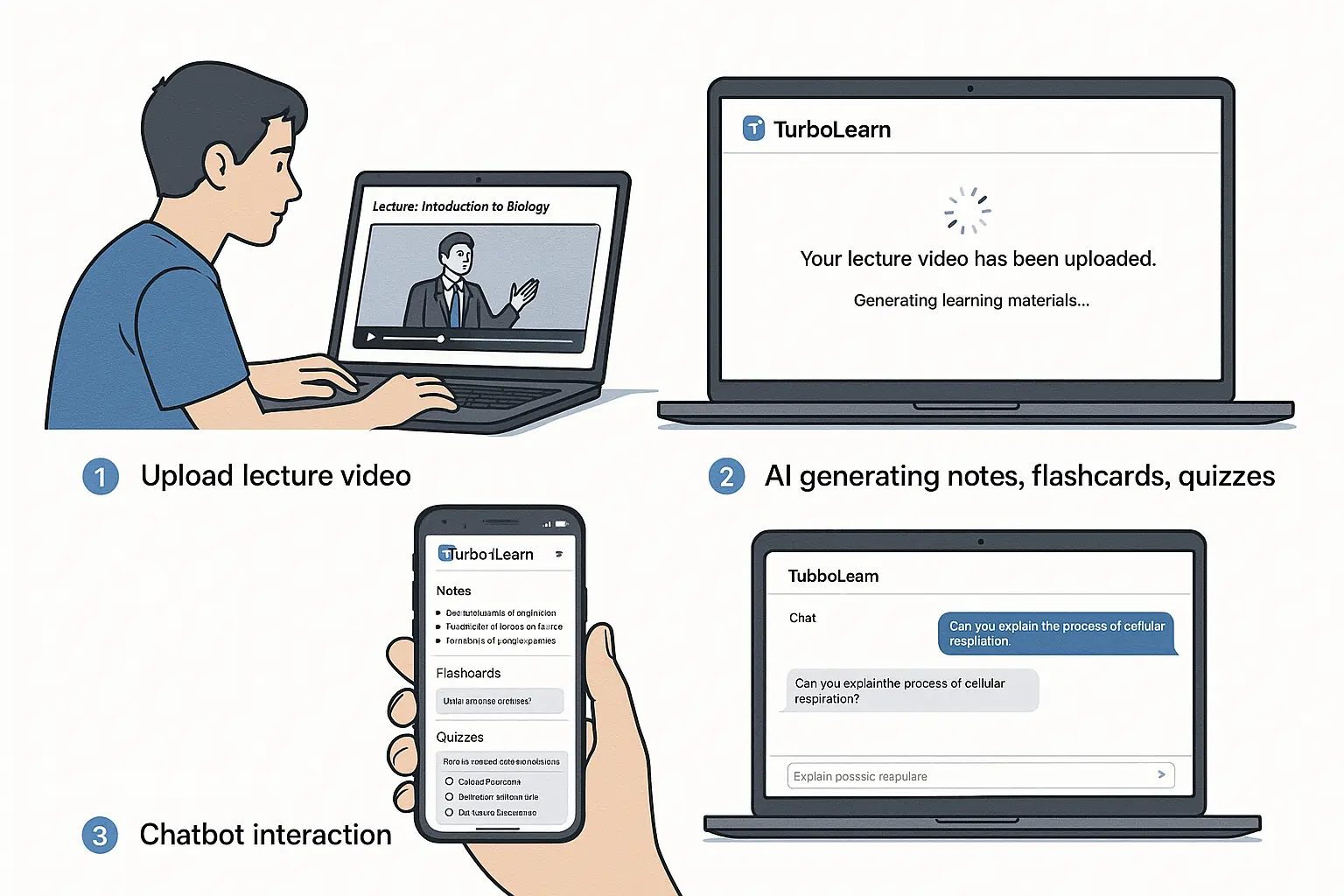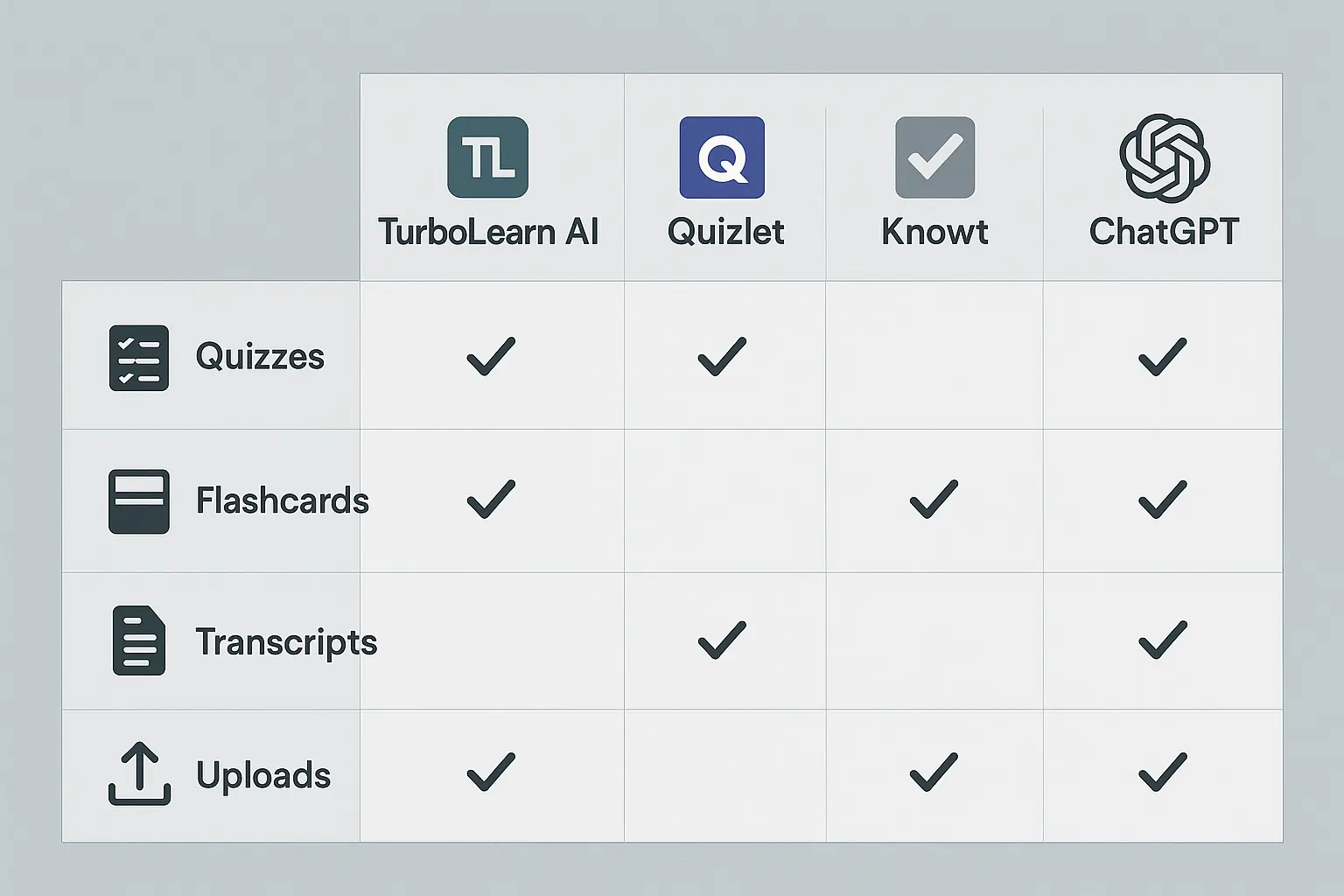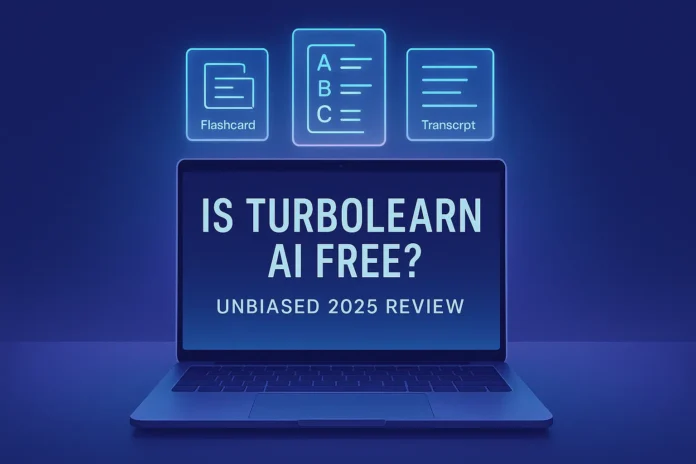Yes, TurboLearn AI offers a free “Starter” plan with limited usage caps. You can upload lectures, create quizzes and flashcards, and interact with its AI chatbot within monthly quotas. But full power lies behind the paid tiers.
In this article, you’ll learn precisely what’s free, how to use it smartly, whether you need to upgrade, and what hidden advantages and drawbacks to watch for.
What features are included in TurboLearn AI’s free plan? The free plan offers a taste, but with strict usage limits. For example, you typically receive ~2 hours of lecture processing, five quiz questions, 1 PDF upload, and 10 chatbot messages monthly. (Humai)
Here’s a comparison:
| Feature | Free (Starter) | Pro / Paid |
|---|---|---|
| Lecture processing hours | ~2 hrs/mo (Humai) | 15 hrs (or more) |
| Quiz questions/tests | 5 per month | 50+ or unlimited |
| PDF uploads | 1 per month | 10+ |
| Chatbot messages | 10 per month | 200+ |
| Access to transcripts | ❌ Not included in free (Online Course Platform Reviews) | ✅ Included in paid tier |
| Unlimited flashcards | ❌ Limited | ✅ Unlimited in Pro or higher (Bold Rankers) |

Example:
Say you upload a 90-minute lecture video. Under the free plan, you’d use up nearly 75% of your monthly allocation just for that one upload. That leaves just ~30 minutes for other content or usage.
How do I use TurboLearn AI’s free plan (step by step)?
You can fully explore the free plan with a straightforward setup. You’ll be able to upload content and generate study aids immediately within the free limits.
Steps:
- Go to the TurboLearn AI site and register (email / Google).
- Log in and upload your content (PDF, audio, video, or YouTube link).
- Wait for AI processing, then view summary, flashcards, and quiz.
- Use a chatbot (within message cap) to clarify topics.
- Export/download outputs (if allowed) for offline review.

Pro Tip: Use your monthly quota on your densest and most essential lectures first to maximise value.
Is the free plan too restrictive for serious learners?
Possibly for heavy use, the limits bite early. Students enrolled in dense courses may find that they reach their caps quickly, especially with long videos or numerous quizzes.
Examples of constraint pain points:
- You upload a 2-hour lecture (uses full quota) → no room for extra readings or YouTube clips.
- You need more than five quiz items in a topic → locked behind a paywall.
- You want transcripts to review text later → not unlocked on free.
That said, the free plan is practical when:
- You’re evaluating the platform.
- You have light usage (weekend learners, one course).
- You want to test the interface before making a purchase.
Internal link: Check “Upgrade benefits” on our TurboLearn Pro features page.
What hidden perks does the free plan offer that competitors miss?
There are subtle benefits tucked behind the free tier’s surface. These are advantages many reviews neglect to mention.
- Export/download flexibility: Even with free access, you can export notes/flashcards for offline review. (TurboLearn requires internet for processing, but allows saved materials for later) (Tools for Humans)
- Trial access to premium features: Occasionally, free users may get limited “preview” access to transcripts or community features.
- Collaboration/sharing: In some cases, free users can share decks or notes (even if limited) with classmates.
- Low barrier to entry: No credit card is required for the starter plan, allowing users to test the service risk-free. (AITECHFY)
These perks give you usable value even if you never upgrade, especially when combined with structured learning strategies like those in our genetic engineering & AI bioinformatics guide.
Who should stick to the free plan, and who should upgrade?
The free plan is suitable for casual or exploratory users; heavy users should consider upgrading.
| User Type | Recommended Path |
|---|---|
| Occasional learner, one subject | Stay free; monitor usage |
| Multi-course student | Likely upgrade to get more hours/quizzes |
| Course creator/educator | Upgrade for transcript and bulk features |
| Study group/team use | Pro or team licenses are needed |
When upgrade makes sense:
- You hit quota mid-month.
- You need transcripts, unlimited flashcards, or integrations.
- You’re uploading content frequently across multiple sources.
In those cases, the $3.99 to $8.99 / mo paid tiers provide much more breathing room.
Is TurboLearn AI safe, legit, and trustworthy?
Yes, TurboLearn AI appears legitimate; however, some user feedback raises concerns.
It claims encryption and GDPR compliance, but real users report login bugs, crummy UI issues, and a low safety score. (JustUseApp gives it 46/100)
What its security & privacy policy claims
-
TurboLearn (now Turbo AI) states that user data is stored securely, likely using AES encryption and cloud infrastructure (AWS or similar).
-
It claims compliance with standard privacy frameworks (e.g., GDPR), although regional and data retention details are vague.
-
The tool utilises cloud processing for summarisation and modelling, so raw content is transmitted to their servers (i.e., not entirely local).
User reviews and bug reports
-
~46% of user reviews on JustUseApp are positive; many report login failures, session drops, or a mismatch between app and website accounts.
-
Example user quote: “I paid for premium, but when I switched devices, the platform would not recognise my login even though billing went through.”
-
Fritz’s hands-on review mentions occasional UI latency and some interface elements feeling “beta.” Fritz ai
Academic/technical legitimacy
-
A technical analysis (CLRN) examines model reliability, algorithm transparency, and overall architecture; however, without a full audit, claims are plausible but not independently verified. California Learning Resource Network
-
No published whitepaper on model accuracy, no public API benchmark, no third-party security audit.
Verdict: Use it, but avoid uploading highly sensitive content until you have fully confirmed trust. Always keep copies of original materials.
How does TurboLearn AI compare with Knowt, Quizlet, and other tools?
TurboLearn’s free tier is moderately stronger than basic tools but weaker than the best free tools.
Below is a side-by-side snapshot (free version) of TurboLearn AI vs major competitors:
| Feature / Attribute | TurboLearn AI Free | Knowt Free | Quizlet Free | ChatGPT (free / basic) |
|---|---|---|---|---|
| Upload video/audio / PDF | ✅ (limited) | ✅ (some support) | ❌ (manual import) | ✅ (via prompt, but manual) |
| Number of quizzes/questions | ~5 / mo | More generous in the free plan (variable), | Limited | Unlimited (but you craft them) |
| Flashcards | ✅ (limited) | ✅ | ✅ with an extensive community library | Manual generation via prompts |
| Transcripts/text extraction | ❌ (locked) | Partial | ❌ | Via prompt + tools |
| Collaboration/sharing | Some sharing possible | Stronger community/sharing tools | Powerful community sharing | Doesn’t focus on sharing study decks |
| Offline access | ❌ (requires internet) | Varies | No or limited | Offline prompts are possible if the local model |
| Ease of use & interface | Mixed reviews: some parts feel not fully polished, | More mature UI focus | Very polished, established | Universal interface, but no built-in study UX |

Example comparison insight:
Knowt’s free plan tends to offer more leniency with quizzes/flashcards than TurboLearn’s starter, but TurboLearn supports more input formats (video and audio).
In practice:
-
If you only want flashcards and user-shared sets, Quizlet may be the better choice. However, for learners evaluating broader ecosystems, posts like ‘Top AI Cloud Business Tools’ show how TurboLearn fits within the AI tool stack.
-
If you want one tool to digest lectures, extract notes, and quiz you, TurboLearn wins in feature breadth.
-
ChatGPT gives flexibility but lacks structure (you build your workflows).
-
Knowt sits in the middle, offering less flash but more stability in some cases, according to alternative reviews.
What tips and strategies help you get the most from the free plan?
Utilise these strategies to maximise your free allotment and thoroughly test the system.
-
Prioritise dense content
Upload lecture or video content with many learning points (as opposed to short videos), and you get more “value per upload hour.”
Example: A 90-minute lecture with segmented chunks is more effective than many short clips. -
Batch uploads
Instead of uploading many small files, merge related ones (if the format allows) into a single file to minimise overhead. -
Edit/trim content before upload.
Remove unnecessary filler (lecturer intros, breaks) so AI can focus on the key portion, optimising your hours ‘ use. -
Save outputs immediately
After AI generates notes/flashcards, export them immediately before your free quotas refresh or the session logs out. -
Monitor usage
Use the built-in dashboards (if available) to see how much of your allotment you’ve consumed by mid-month. -
Test premium features during trial windows
Many platforms offer “preview access” periods, which users can use to push limits and evaluate whether the upgrade is worth it. -
Alternate with free competitor tools
If you hit limits in TurboLearn, you can supplement with Knowt or Quizlet for overflow work.
What future updates or roadmap should you watch for?
TurboLearn AI is evolving. Here are some key features to look out for.
-
Offline mode / local processing: Many users request the ability to process content without continuous internet access.
-
Higher free threshold: as competition tightens, they may expand the free hours/quizzes.
-
Third-party integrations (Notion, Google Docs, LMS sync): already hinted at in some product descriptions.
-
Team / EDU / Institutional licenses: Bulk pricing, campus deployment, and expanded sharing.
-
Improved UI polish, stability, and bug fixes: multiple users and reviewers have mentioned rough interface edges.
-
Model accuracy, transparency & audit reports: for trust / E-E-A-T, a public audit or accuracy benchmark would boost credibility.
Conclusion & Recommendation
Start learning with TurboLearn AI’s free plan, which offers a risk-free taste. But it’s not enough for heavy use, exam prep across multiple classes, or creating large study decks.
Use the free plan to test:
-
whether its summaries/flashcards fit your style,
-
whether the UI feels stable,
-
whether you’ll bump into usage ceilings too soon.
If you regularly hit those caps or need transcripts, upgrading to Pro makes sense. Many users also pair TurboLearn with other study tools to enhance their AI mastery in their workflow.
My verdict (for students/learners):
TurboLearn AI has strong potential, especially for users who prefer one tool over juggling multiple ones. However, treat the free version as a proof-of-concept rather than your complete study engine. If you’re curious about AI’s broader creative potential, consider exploring guides like the best AI sound effects to see how versatile these tools can be.



